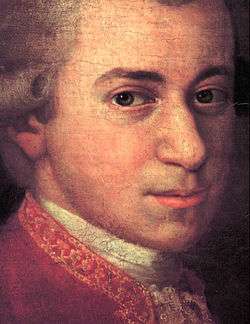Symphony, K. 111+120 (Mozart)
The Symphony in D major "No. 48", K. 111+120, was composed by Wolfgang Amadeus Mozart in 1771. The first two movements are from the overture to the opera Ascanio in Alba, K. 111, and the last movement, K. 120, was composed separately.
The symphony is scored for two flutes, two oboes, two horns, two trumpets, timpani and strings. The trumpets and timpani are silent for the second movement.
The symphony consists of the following movements:
- Allegro assai, 4/4
- Andante grazioso, 3/8
- Presto, 3/8
The Alte Mozart-Ausgabe (published 1879–1882) gives the numbering sequence 1–41 for the 41 numbered symphonies. The unnumbered symphonies (some, including K. 120,[1] published in supplements to the Alte-Mozart Ausgabe until 1910) are sometimes given numbers in the range 42 to 56, even though they were written earlier than Mozart's Symphony No. 41 (written in 1788). The symphony K. 111+120 is given the number 48 in this numbering scheme.
References
- ↑ Only the last movement was published in the Alte Mozart-Ausgabe.
External links
- Sinfonie in D K. 111+120: Score and critical report (German) in the Neue Mozart-Ausgabe
- Symphony No. 48, K. 111+120: Scores at the International Music Score Library Project
- MozartForum: K120/111a Finale in D for Ascanio in Alba Overture
